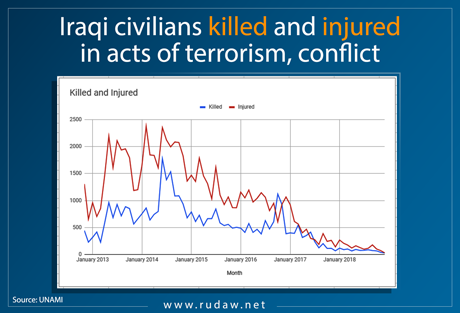ERBIL, Kurdistan Region – The numbers of Iraqis dying from terrorism and conflict continues to drop, according to the most recent figures from the United Nations that recorded record low casualty figures for the third month in a row.
“During December 2018 a total of 32 Iraqi civilians were killed and another 32 injured in acts of terrorism and conflict-related violence,” the UN mission in Iraq (UNAMI) stated on Thursday.
In November, UNAMI recorded 41 civilian deaths and 69 in October – the lowest numbers in six years.

Civilian casualties were high during the years of insurgency after the withdrawal of US forces and with the arrival of ISIS.
Many civilians were also killed and injured during the war to defeat ISIS, especially in the battle for Mosul from October 2016 to July 2017.
ISIS was declared defeated in December 2017, but remnants and sleeper cells remain a security threat, especially in security gaps between the Peshmerga and Iraqi forces in the disputed areas.
In December, Nineveh was the worst-affected province with a total of 26 casualties – seven deaths and 19 injuries. Baghdad was the deadliest province with 17 people killed and three injured.
“UNAMI views these figures as more than mere statistics,” said new UNAMI chief Jeanine Hennis-Plasschaert. “Every civilian death documented by UNAMI over the years represents a family grieving and struggling to come to terms with its loss. Each injury or maiming of a civilian represents immense individual and societal suffering.”
With the declining casualty numbers, UNAMI said it will no longer publish monthly reports, but only in special circumstances. While acknowledging increasing stability and security in Iraq, it noted caution saying “the conditions necessary for a sustained reduction in violence remain very fragile.”
“During December 2018 a total of 32 Iraqi civilians were killed and another 32 injured in acts of terrorism and conflict-related violence,” the UN mission in Iraq (UNAMI) stated on Thursday.
In November, UNAMI recorded 41 civilian deaths and 69 in October – the lowest numbers in six years.

Civilian casualties were high during the years of insurgency after the withdrawal of US forces and with the arrival of ISIS.
Many civilians were also killed and injured during the war to defeat ISIS, especially in the battle for Mosul from October 2016 to July 2017.
ISIS was declared defeated in December 2017, but remnants and sleeper cells remain a security threat, especially in security gaps between the Peshmerga and Iraqi forces in the disputed areas.
In December, Nineveh was the worst-affected province with a total of 26 casualties – seven deaths and 19 injuries. Baghdad was the deadliest province with 17 people killed and three injured.
“UNAMI views these figures as more than mere statistics,” said new UNAMI chief Jeanine Hennis-Plasschaert. “Every civilian death documented by UNAMI over the years represents a family grieving and struggling to come to terms with its loss. Each injury or maiming of a civilian represents immense individual and societal suffering.”
With the declining casualty numbers, UNAMI said it will no longer publish monthly reports, but only in special circumstances. While acknowledging increasing stability and security in Iraq, it noted caution saying “the conditions necessary for a sustained reduction in violence remain very fragile.”



Comments
Rudaw moderates all comments submitted on our website. We welcome comments which are relevant to the article and encourage further discussion about the issues that matter to you. We also welcome constructive criticism about Rudaw.
To be approved for publication, however, your comments must meet our community guidelines.
We will not tolerate the following: profanity, threats, personal attacks, vulgarity, abuse (such as sexism, racism, homophobia or xenophobia), or commercial or personal promotion.
Comments that do not meet our guidelines will be rejected. Comments are not edited – they are either approved or rejected.
Post a comment